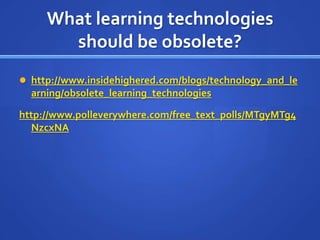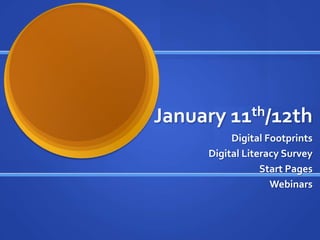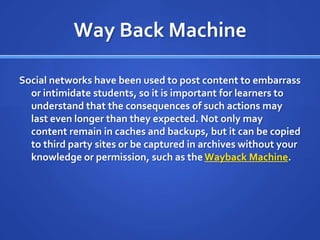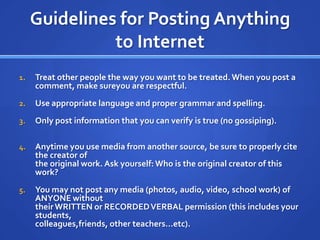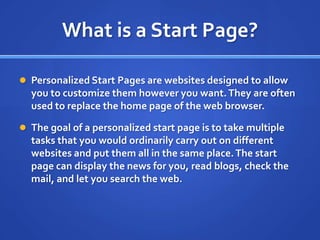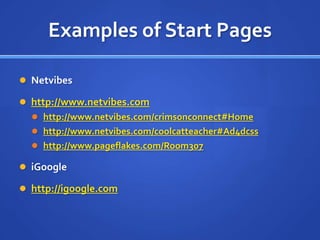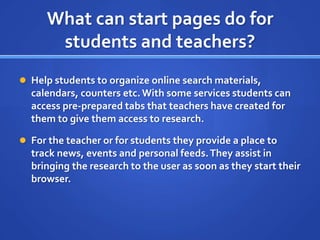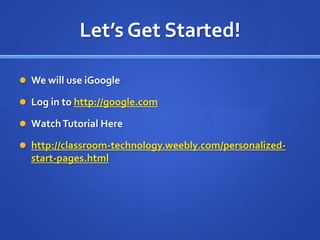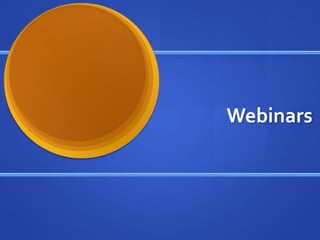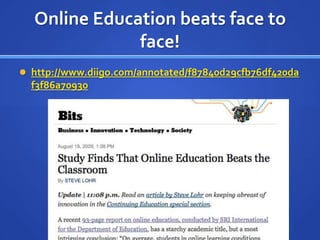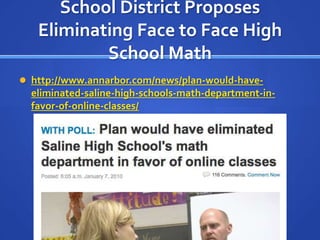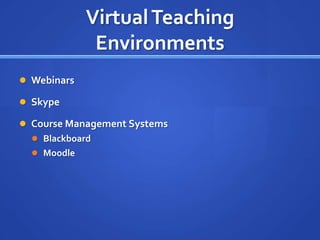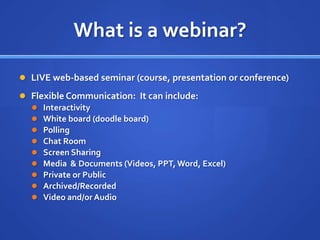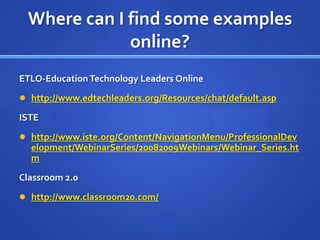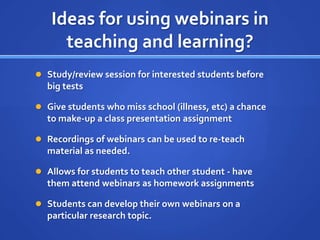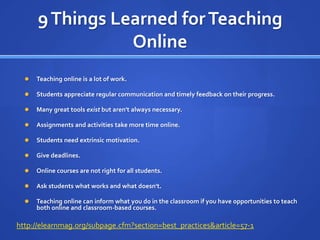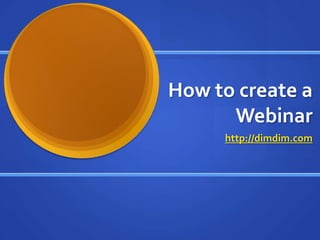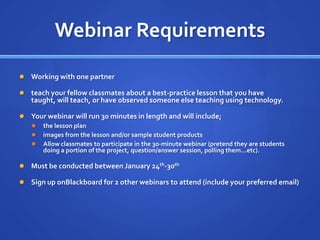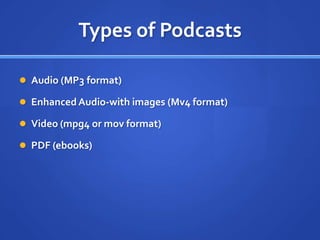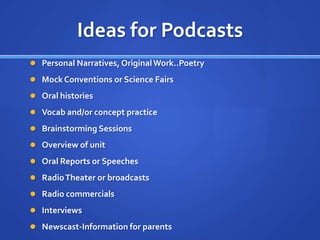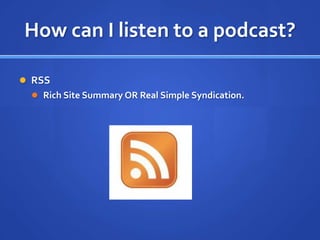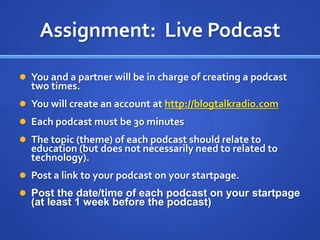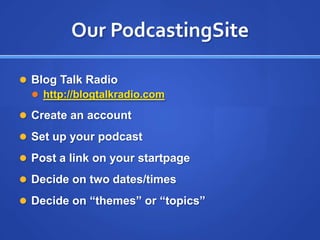Start Pages
- 1. What learning technologies should be obsolete?http://www.insidehighered.com/blogs/technology_and_learning/obsolete_learning_technologieshttp://www.polleverywhere.com/free_text_polls/MTgyMTg4NzcxNA
- 2. January 11th/12thDigital FootprintsDigital Literacy SurveyStart PagesWebinars
- 3. In Cyberspace…Don’t assume anything you send or post is going to remain private.There is no changing your mind in cyberspace—anythingyou send or post will never truly go away.Don’t give in to the pressure to do something that makesyou uncomfortable, even in cyberspace.Consider the recipient’s reaction.Nothing is truly anonymous.
- 4. Way Back MachineSocial networks have been used to post content to embarrass or intimidate students, so it is important for learners to understand that the consequences of such actions may last even longer than they expected. Not only may content remain in caches and backups, but it can be copied to third party sites or be captured in archives without your knowledge or permission, such as the Wayback Machine.
- 5. Movie: Digital Dossierhttp://www.youtube.com/watch?v=79IYZVYIVLA
- 6. Guidelines for Posting Anything to InternetOnly post things that you would want everyone (in school, at home, in other countries)to know. Do not share personal information. Ask yourself: Could someone find me or the person I am posting about (in real life) based on this information?Think before you post. Ask yourself: What could be the consequences of this post?Know who you’re communicating with. Ask yourself: Who is going to look at this, and how are they going to interpret my words?Consider your audience and that you’re representing your school and your professional self.
- 7. Guidelines for Posting Anything to InternetTreat other people the way you want to be treated. When you post a comment, make sureyou are respectful.Use appropriate language and proper grammar and spelling.Only post information that you can verify is true (no gossiping).Anytime you use media from another source, be sure to properly cite the creator ofthe original work. Ask yourself: Who is the original creator of this work?You may not post any media (photos, audio, video, school work) of ANYONE withouttheir WRITTEN or RECORDED VERBAL permission (this includes your students,colleagues,friends, other teachers...etc).
- 8. Digital Literacy Survey AssignmentAt least 10 questionsGive to your students (between now and March 1st)Present Findings on March 2nd/3rdHow would you develop lesson plans with this knowledge?What did you learn? What surprised you?Create with Googlehttp://google.com
- 9. Start Pages
- 10. What is a Start Page?Personalized Start Pages are websites designed to allow you to customize them however you want. They are often used to replace the home page of the web browser.The goal of a personalized start page is to take multiple tasks that you would ordinarily carry out on different websites and put them all in the same place. The start page can display the news for you, read blogs, check the mail, and let you search the web.
- 11. Examples of Start PagesNetvibeshttp://www.netvibes.comhttp://www.netvibes.com/crimsonconnect#Homehttp://www.netvibes.com/coolcatteacher#Ad4dcsshttp://www.pageflakes.com/Room307iGooglehttp://igoogle.com
- 12. Adding ContentMost websites will spell it out by having a link or button called "add content" at the top of the page, usually at the top-left or top-right.There are two basic types of content you can add to the page: web feeds and widgets.A web feed, also known as an RSS feed, is used to read the news and can bring you the latest entries from your favorite websitesThe second type of content provided are components called widgets. Popular widgets used on include widgets that check email, a notepad for writing down reminders, a local weather checker, a scheduler, and search features for various websites or even the entire web. Some personalized start pages even allow you to add your favorite custom widget.
- 13. What can start pages do for students and teachers?Help students to organize online search materials, calendars, counters etc. With some services students can access pre-prepared tabs that teachers have created for them to give them access to research.For the teacher or for students they provide a place to track news, events and personal feeds. They assist in bringing the research to the user as soon as they start their browser.
- 14. Let’s Get Started!We will use iGoogleLog in to http://google.comWatch Tutorial Herehttp://classroom-technology.weebly.com/personalized-start-pages.html
- 15. Homework!Make sure you email your startpage URL to Lizelikeren@umich.eduOn Your Start Page:Link to your PodcastInformation about your upcoming Podcasts
- 16. Webinars
- 17. How can knowing how to Teach Virtually be helpful?The rise of virtual schooling Michigan Virtual High SchoolJob opportunities for teachersInclude home-bound studentsCreate professional development opportunitiesConferencingCommittee work
- 18. Online Education beats face to face!http://www.diigo.com/annotated/f87840d29cfb76df420daf3f86a70930
- 19. School District Proposes Eliminating Face to Face High School Mathhttp://www.annarbor.com/news/plan-would-have-eliminated-saline-high-schools-math-department-in-favor-of-online-classes/
- 20. Virtual Teaching EnvironmentsWebinarsSkypeCourse Management Systems BlackboardMoodle
- 21. What is a webinar?LIVE web-based seminar (course, presentation or conference)Flexible Communication: It can include:InteractivityWhite board (doodle board)PollingChat RoomScreen SharingMedia & Documents (Videos, PPT, Word, Excel)Private or PublicArchived/RecordedVideo and/or Audio
- 22. Where can I find some examples online?ETLO-Education Technology Leaders Onlinehttp://www.edtechleaders.org/Resources/chat/default.aspISTEhttp://www.iste.org/Content/NavigationMenu/ProfessionalDevelopment/WebinarSeries/20082009Webinars/Webinar_Series.htmClassroom 2.0http://www.classroom20.com/
- 23. Ideas for using webinars in teaching and learning?Study/review session for interested students before big testsGive students who miss school (illness, etc) a chance to make-up a class presentation assignmentRecordings of webinars can be used to re-teach material as needed.Allows for students to teach other student - have them attend webinars as homework assignmentsStudents can develop their own webinars on a particular research topic.
- 24. 9 Things Learned for Teaching OnlineTeaching online is a lot of work.Students appreciate regular communication and timely feedback on their progress.Many great tools exist but aren't always necessary.Assignments and activities take more time online.Students need extrinsic motivation.Give deadlines. Online courses are not right for all students. Ask students what works and what doesn't.Teaching online can inform what you do in the classroom if you have opportunities to teach both online and classroom-based courses.http://elearnmag.org/subpage.cfm?section=best_practices&article=57-1
- 25. How to create a Webinarhttp://dimdim.com
- 26. Webinar RequirementsWorking with one partnerteach your fellow classmates about a best-practice lesson that you have taught, will teach, or have observed someone else teaching using technology. Your webinar will run 30 minutes in length and will include;the lesson planimages from the lesson and/or sample student productsAllow classmates to participate in the 30-minute webinar (pretend they are students doing a portion of the project, question/answer session, polling them…etc). Must be conducted between January 24th-30thSign up onBlackboard for 2 other webinars to attend (include your preferred email)
- 29. What is a Podcast?iPod + Broadcast=PodcastAn audio recording that is distributed via the internet.It can be downloaded and listen to via a PC or mobile deviceIt has a syndicated feed that uses RSS to pull the files to the user
- 30. Types of PodcastsAudio (MP3 format)Enhanced Audio-with images (Mv4 format)Video (mpg4 or mov format)PDF (ebooks)
- 31. Ideas for PodcastsPersonal Narratives, Original Work..PoetryMock Conventions or Science FairsOral historiesVocab and/or concept practiceBrainstorming SessionsOverview of unitOral Reports or SpeechesRadio Theater or broadcastsRadio commercialsInterviewsNewscast-Information for parents
- 32. Podcasting ProcessDecide on the “type” of podcastRadio broadcast, Radio Theater, Interview…etcWrite a pitchParagraph on “this is a podcast about…”Get it approved by teacher, then…Write a scriptGet the Media Images, sounds, music…etcPractice, Practice, PracticeRecord the PodcastPost to the web
- 34. Sample Classroom PodcastsEducators Podcasting Networkhttp://epnweb.orgTony Vincenthttp://learninginhand.com/podcasting/find.htmlPodcasts for Teachershttp://www.podcastforteachers.org/Wes Fryer’s Podcasting Sitehttp://teachdigital.pbwiki.com/podcasting
- 35. How can I listen to a podcast?RSSRich Site Summary OR Real Simple Syndication.
- 36. Assignment: Live PodcastYou and a partner will be in charge of creating a podcast two times.You will create an account at http://blogtalkradio.comEach podcast must be 30 minutesThe topic (theme) of each podcast should relate to education (but does not necessarily need to related to technology).Post a link to your podcast on your startpage.Post the date/time of each podcast on your startpage (at least 1 week before the podcast)
- 37. Sample Podcast0-.30: Introduction Music and overview of agenda
- 38. .30-5:00: Current Events in Education
- 39. 5:00-25:00: Interview with School Principal on how they deal with cell phones and students.
- 40. 25:00-30:00: Closing article—select a few quotes (something to wrap up discussion on topic of cell phones)Sample Blog Talk Podcastshttp://www.blogtalkradio.com/mac09http://www.blogtalkradio.com/soe0910http://www.blogtalkradio.com/elikeren
- 41. Our PodcastingSiteBlog Talk Radiohttp://blogtalkradio.comCreate an accountSet up your podcastPost a link on your startpageDecide on two dates/timesDecide on “themes” or “topics”
Editor's Notes
- 44 states have virtual learning programs. Michigan Virtual School is one of the largest online course providers in the nation with 11,000 course registrations in 2007-2008. MVS partners with local schools to provide core and supplemental courses with over 100 part-time teachers that are Michigan certified, highly qualified instructors. MVS is primarily a supplemental program, although MVS has one full-time program to meet the needs of the Traverse City Area Public Schools.
- Liz
- Liz
- Liz
- Kristin & Chris
